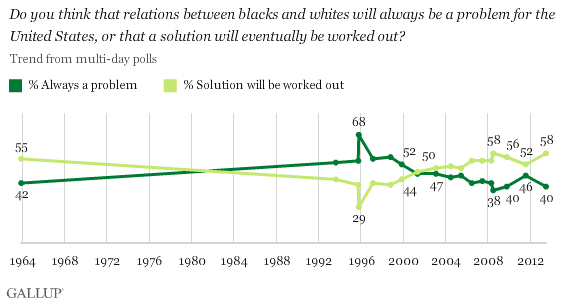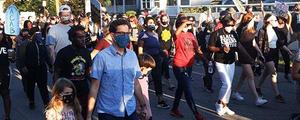PRINCETON, NJ -- Americans view relations between various racial and ethnic groups positively, ranging from 87% who describe white-Asian relations as good to 60% describing black-Hispanic relations as good.
![Next, we’d like to know how you would rate relations between various groups in the United States these days. Would you say relations between -- [RANDOM ORDER] -- are very good, somewhat good, somewhat bad, or very bad? June-July 2013 results](http://content.gallup.com/origin/gallupinc/GallupSpaces/Production/Cms/POLL/buhqxawmeeymib4kzor8lq.png)
The results are from Gallup's Minority Rights and Relations poll, conducted June 13-July 5, and completed before last week's verdict in the George Zimmerman trial that brought race relations back into the spotlight. A jury found Zimmerman, a white Hispanic neighborhood watch captain, not guilty in the shooting death of Trayvon Martin, a black teen. The two had scuffled before Zimmerman shot Martin.
The poll cannot address the impact the verdict may have had on public perceptions of U.S. race relations in recent days. However, Americans' views of various intergroup relations had generally improved since 2008, the last year the poll was conducted. Now, Americans' assessment of white-Asian relations is the most positive it has been in Gallup's trend, originating in 2001. Their views of white-black, white-Hispanic, and black-Hispanic relations are the most positive since 2004.

A separate question in the poll that assesses black-white relations only, and dates back to 1963, also shows a more positive current view of race relations. Forty percent of Americans say black-white relations will always be a problem for the United States. That is two percentage points above the low of 38% from June 2008. Meanwhile, 58% currently believe a solution to black-white relations will eventually be worked out, tied for the high from June 2008.

The high of 68% of Americans saying black-white relations would always be a problem came in 1995, shortly after a California jury found O.J. Simpson not guilty of murdering Nicole Brown Simpson and Ron Goldman. Readings in more recent years have been on par with where they were in December 1963, one month after John F. Kennedy's assassination and four months after Martin Luther King's "I Have a Dream" speech.
Racial and Ethnic Groups Differ Most in Ratings of Black-Hispanic Relations
For the most part, whites, blacks, and Hispanics do not vary much in how they perceive relations between racial and ethnic groups. At least eight in 10 of each group sees white-Asian relations as good, and between 63% and 72% of each group views white-Hispanic and white-black relations as good. Where they differ most is their perceptions of black-Hispanic relations. Whites, at 56%, are far less likely to say black-Hispanic relations are good than are blacks, at 76%. Hispanics' views of black-Hispanic relations fall in between, at 64%.

In the years Gallup has asked this question, blacks have been substantially more positive than whites about black-Hispanic relations, with Hispanics more positive than whites but less positive than blacks.
Implications
Americans' views of race relations had been quite positive from a historical perspective prior to the Zimmerman verdict, which has sparked protests around the country and calls for Zimmerman to be tried in federal court for violating Martin's civil rights.
It is not clear whether the Zimmerman verdict will force Americans to re-evaluate their views of race relations, in the short term or the long term. There is a precedent for a significant short-term change in perceptions of race relations after the O.J. Simpson murder trial, although that was likely a much higher-profile case than the Zimmerman case. Last year, shortly after Martin was killed, 61% of Americans said they were following the news about the story closely, roughly average for a news story in Gallup's records.
At that time, blacks were much more likely than whites to be following the case, and much more likely to believe race was a factor in Martin's death. That suggests that, to the extent the Zimmerman verdict affects views of race relations, it probably would do so more among blacks than among whites.
Survey Methods
Results for this Gallup poll are based on telephone interviews conducted June 13-July 5, 2013, with a random sample of 4,373 adults, aged 18 and older, living in all 50 U.S. states and the District of Columbia, including oversamples of black and Hispanic adults. The total sample is weighted to represent racial and ethnic groups proportionately to their share of the population. All respondents had previously been interviewed for the Gallup Daily tracking survey.
For results based on the total sample of national adults, one can say with 95% confidence that the margin of sampling error is ±2 percentage points.
For results based on the total sample of 2,149 non-Hispanic whites, one can say with 95% confidence that the margin of sampling error is ±3 percentage points.
For results based on the total sample of 1,010 non-Hispanic blacks, one can say with 95% confidence that the margin of sampling error is ±5 percentage points.
For results based on the total sample of 1,000 Hispanics, one can say with 95% confidence that the margin of sampling error is ±6 percentage points.
Interviews are conducted with respondents on landline telephones and cellular phones, with interviews conducted in Spanish for respondents who are primarily Spanish-speaking. Each sample of national adults includes a minimum quota of 50% cell phone respondents and 50% landline respondents, with additional minimum quotas by region. Landline and cell phone numbers are selected using random digit dial methods. Landline respondents are chosen at random within each household on the basis of which member had the most recent birthday.
Samples are weighted to correct for unequal selection probability, nonresponse, and double coverage of landline and cell users in the two sampling frames. They are also weighted to match the national demographics of gender, age, race, Hispanic ethnicity, education, region, population density, and phone status (cellphone only/landline only/both, and being cellphone mostly). Demographic weighting targets are based on the March 2012 Current Population Survey figures for the aged 18 and older U.S. population. Phone status targets are based on the July-December 2011 National Health Interview Survey. Population density targets are based on the 2010 census. All reported margins of sampling error include the computed design effects for weighting.
In addition to sampling error, question wording and practical difficulties in conducting surveys can introduce error or bias into the findings of public opinion polls.
View methodology, full question results, and trend data.
For more details on Gallup's polling methodology, visit www.gallup.com.
